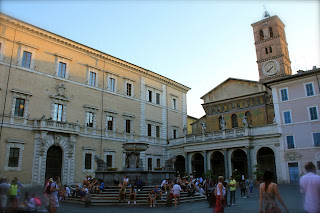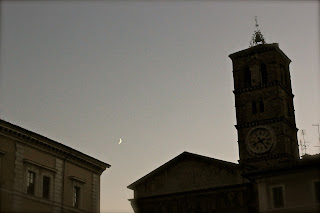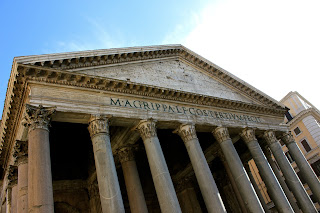After a 15-hour drive from Rome to Sicily through the straight of Messina—with Gabriele and I head bobbing to the likes of Alt-J and Jay-Z—we arrived at our beachside campsite just east of Patti, our first stop on the Tyrrhenian Coast. After a couple of days of gorging myself on granita, and sunbathing and splashing around in the surf, I decided to check out Taormina, one of Sicily’s premier attractions. At just over 100 kilometres from Patti, I figured it would make for easy day trip on my own. Silly me—I forgot to factor in that I was in Sicily. After a 30-minute train ride and a three-hour bus trip (for real!), I arrived at a perfectly preserved medieval town (yay!), soaked in rain and swarming with tourists (ugh.). After walking along Corso Umberto I, Taormina’s pedestrian-friendly main avenue, lined with antique and jewellery shops and designer boutiques (far removed from the economic realities of other Southern Italian and Sicilian towns), I wandered up to the Teatro Greco. Built in the third century BC, this horseshoe shaped theatre is spectacularly situated, suspended between sea and sky, with Mt Etna looming on the horizon. Gazing out, I felt that the view alone was well worth the effort of getting to Taormina, but I still had to get back "home"; and, what a disaster that turned out to be. As I had missed the three-hour bus back to Messina, I had to take a bus down to Taormina’s train station (over four kilometres from the town itself, no sidewalks), wait an hour and a half for the next train, which then proceeded to break down just outside of Messina. Stuck on the train for two hours, I struck up conversations in Italian with just about everyone, and helped translate what was going on for other tourists whose comprehension of the circumstances and the language was nil. When we finally pulled into the station, it was complete chaos. Thankfully, Rosanna and Gabriele met me in Messina. On our drive back to our campsite, we commiserated on the Sicilian situation: While overloaded with natural beauty and cultural treasures, the region’s undersupply of infrastructure and struggles against Mafia-driven corruption have rendered it so underdeveloped that it is barely recognizable as an Italian or European entity.
Granita
Taormina
The following morning, we left for a day cruise around the Aeolian Islands. With a cobalt blue sea, black sand beaches, and smouldering volcanic landscapes, the seven islands and various uninhabited islets of the Aeolian archipelago are (for the most part) gorgeous, and were designated a UNESCO World Heritage Site in 2000 for good reason. We visited both Lipari and Vulcano: The former has a charming town centre, flower-hung alleys and a fabulous bakery that has been rolling out pastries since 1930; the latter is pretty nondescript, but does smell of (sulphurous) rotten eggs.
Aeolian Islands
Lipari, Aeolian Islands
Lipari, Aeolian Islands
Lipari, Aeolian Islands
Next up? Cefalu. Wedged between a natural bay and a towering, rocky crag, and with sandy beaches, winding medieval streets, and an assortment of shops, boutiques, and restaurants, I can understand why the holiday resort town was hopping with Italian and other European tourists. After grabbing (an overpriced) granita in the piazza del Duomo, we ventured into the square’s grandiose cathedral and admired the elaborate twelfth century mosaics inside, before catching a bus back to our campsite.
I should also note that by mid-August, my Italian had improved dramatically, enabling me to not only converse with other Italians, but to eavesdrop on conversations between locals. One of my favourite snippets took place on this day's bus ride, and went a little something like this:
Woman 1: Hey! How are you?
Woman 2: Good, thanks. How are you?
Woman 1: Good. How is your family? How is your son? Is he in school? Is he studying?
Woman 2: He is neither in school, nor studying. He just bought his degree!
Woman 1: Bought his degree? That’s fantastic! Congratulations!
Cue massive sigh.
Duomo, Cefalu
Duomo, Cefalu
Pasta, Cefalu
Cefalu
Cefalu
Cefalu
That same evening, we drove west to Palermo, whose notoriety in recent years derives more from the Mafia's pervasive influence than from anything else. The following morning, while out exploring, I began to understand what a shame this is for Sicily, and for all of Italy. Palermo is a treasure trove of architectural fusion, with Byzantine, Arab, Norman, Renaissance and baroque styles scattered all over the city, but these are often hidden behind dilapidated apartment complexes and shabby market stalls.
After munching on some "mandorle" (together with granite and cannoli, "mandorle" completes the Sicilian dessert-for-breakfast trifecta), I accompanied Rosanna, Gabriele and co. to the Palazzo dei Normanni, the Cattedrale and the Mercato di Ballaro, Palermo's busiest street market. After checking out the Chiesa Capitolare di San Cataldo, a twelfth century church with dusty-pink bijoux domes, and the nearby Fontana Pretoria that was reminiscent of the Trevi fountain, but without the crowds, we headed to the Quattro Canti, the intersection of four streets that form the heart of the city.
"Dessert di Mandorle", Palermo
Palermo
Mercato di Ballaro, Palermo
Chiesa Capitolare di San Cataldo, Palermo
Fontana Pretoria, Palermo
Quattro Canti, Palermo
The Incident, Palermo
Teatro Massimo, Palermo
Clara, Guido, Gabriele, Rosanna (L-R), Sicilian Superheroes, Palermo
After the incident, we grabbed a quick lunch, and headed straight to the Catacombe dei Cappucini. I urge all of you to perform a Google Image search of the site, as I was not able to bring myself to capture these catacombs on camera. Unlike the catacombs in Paris, or as I understand them, in Rome, here, the mummified bodies and skeletons of some 8,000 Palermitans—grouped together by age, gender, religion and virginal status(?)—are in various stages of decomposition, forming a macabre exhibition that will haunt me for years to come.
By the end of the day, we all felt it was time to say goodbye to Palermo. Just outside the city limits lies Monreale, home to one of the finest examples of Norman architecture in Sicily, the Cattedrale di Monreale. I am not a big fan of churches, but this one, decked out in glimmering gold mosaics, is one of the most beautiful I have ever seen.
Interior, Cattedrale di Monreale
Anti-mafia memorial, Monreale
The following morning, we headed slightly inland to check out the remains of Segesta, a city founded by the ancient Elymians, the indigenous Sicilian population. On the edge of a deep canyon in the midst of wild, desolate hills, lies an amphitheatre, and a gorgeous, fifth century BC Doric temple.
Temple, Segesta
Temple, Segesta
Temple, Segesta
I spent my last couple of days with Seba's family relaxing in San Vito Lo Capo, a spectacularly scenic coastal area that is popular with Italian tourists. There, I fell in love, all over again, with a new Sicilian treat: a white chocolate ice cream bar, dipped in dark chocolate fondant, and covered in pistachio crumbles—the icing on the granite-cannoli-mandorle cake.
Castellammare del Golfo, from a lookout point en route to San Vito Lo Capo
San Vito Lo Capo
Fish Market, San Vito Lo Capo
San Vito Lo Capo






















































